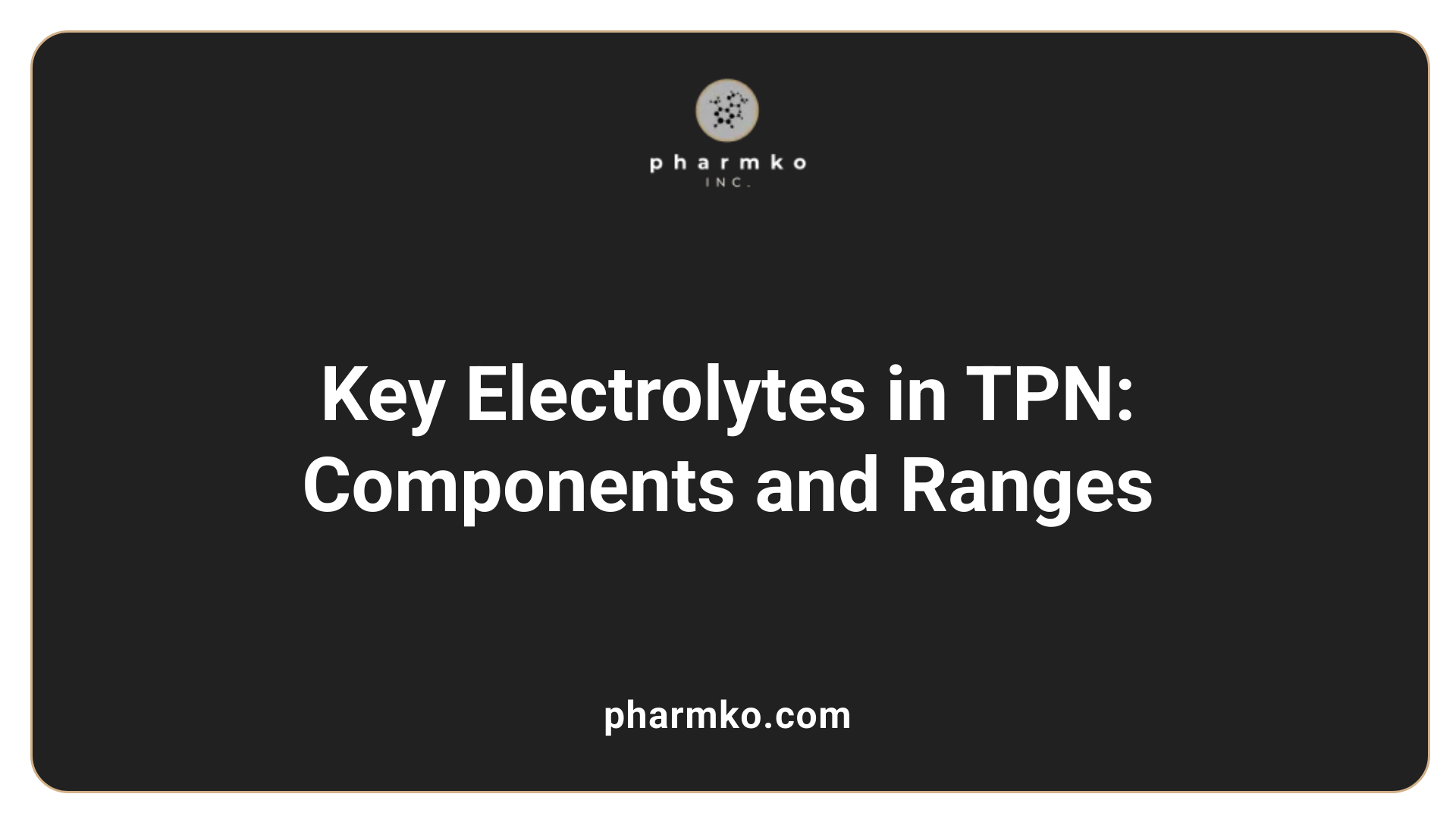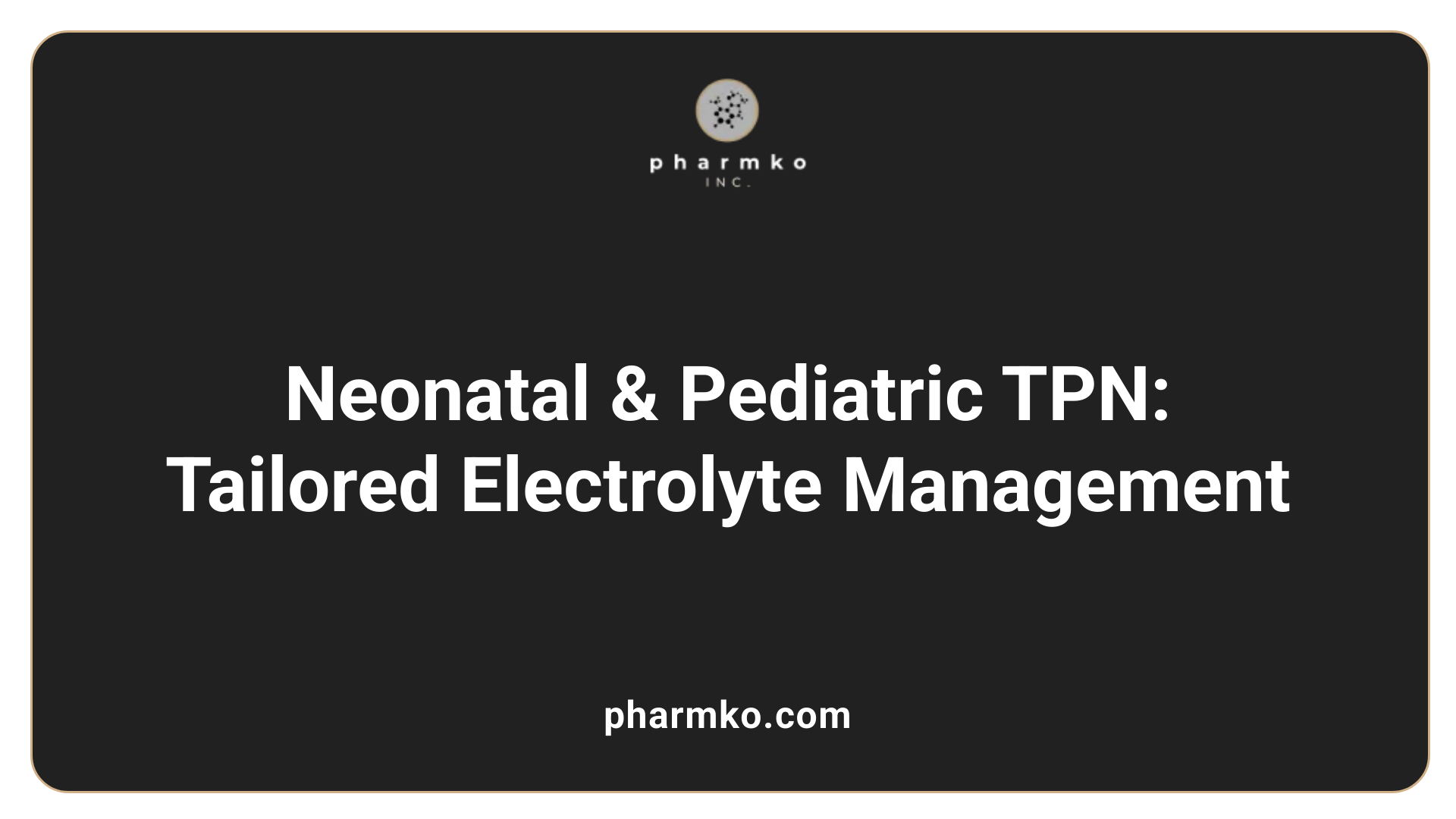How to Create a Balanced TPN Formula for Managing Electrolyte Imbalances
Understanding the Foundations of TPN and Electrolyte Balance
Total parenteral nutrition (TPN) is an essential intervention in patient care when gastrointestinal function is impaired. Central to TPN's success is the formulation of a balanced electrolyte solution that maintains physiological homeostasis. Proper electrolyte management prevents dangerous imbalances such as hypocalcemia, hyponatremia, hypokalemia, and associated cardiac, neuromuscular, and metabolic complications. This article explores principles, ingredients, clinical strategies, and best practices for creating an effective TPN formula tailored to manage and prevent electrolyte imbalances.
Fundamentals of Electrolytes in Human Physiology
Electrolytes are vital ionic minerals in the body that facilitate numerous physiological processes. The main electrolytes include sodium, potassium, magnesium, calcium, chloride, and phosphate, each playing distinct roles.
Sodium is crucial for regulating blood pressure, conducting nerve impulses, and helping muscles contract efficiently. Potassium mainly maintains the heartbeat's regularity, supports nerve and muscle functions, and helps sustain blood pH within normal limits. Magnesium acts as a cofactor for enzymatic reactions, supporting nervous system activity and amino acid metabolism. Calcium is essential for neuromuscular functions, blood clotting, and muscle contraction, while chloride contributes to fluid balance. Phosphate, though not explicitly emphasized here, works alongside calcium in bone health and energy transfer.
These electrolytes significantly influence the body's acid-base balance, water regulation, and neuromuscular activity. For example, sodium and chloride help maintain extracellular fluid volume and osmolality. Proper levels of potassium and magnesium inside cells are vital for nerve impulse transmission and muscle function.
In total parenteral nutrition (TPN), precise electrolyte supplementation is essential to prevent imbalances that can lead to serious health issues such as hypocalcemia, hyponatremia, hypokalemia, or cardiac arrhythmias. Electrolyte compositions are tailored to individual patient needs, typically within specified ranges, and are closely monitored through blood tests.
Maintaining electrolyte homeostasis requires a coordinated effort among the body's systems, especially the kidneys, endocrine glands, and gastrointestinal tract. When designing TPN formulas, healthcare providers consider the patient’s clinical condition, laboratory data, and ongoing losses, adjusting electrolyte content accordingly. Awareness of potential imbalances, such as hypernatremia or hypokalemia, helps guides effective management.
In summary, electrolytes support critical physiological functions, and their careful management in TPN ensures patients maintain homeostasis and avoid life-threatening complications. Proper understanding and adjustment of electrolyte levels are critical in delivering safe and effective nutritional therapy.
The Composition of Essential Electrolytes in TPN

What are the components and recommended ratios of electrolytes in TPN formulas?
Total Parenteral Nutrition (TPN) solutions contain carefully balanced concentrations of vital electrolytes to support bodily functions and maintain electrolyte balance. The main components include sodium, potassium, chloride, calcium, magnesium, and phosphate, which are delivered through specific salts such as sodium chloride, potassium chloride, calcium chloride, magnesium chloride, and sodium acetate.
Typically, the electrolyte amounts per liter of TPN are tailored to meet patient needs, generally consisting of:
| Electrolyte | Typical Range (mEq/L) | Purpose and Role |
|---|---|---|
| Sodium | 100-150 | Regulates blood pressure, nerve impulses, and muscle contraction |
| Potassium | 50-100 | Controls heartbeat, nerve/muscle function, blood pH balance |
| Magnesium | 8-24 | Cofactor for enzymes, nerve function, amino acid metabolism |
| Calcium | 10-20 | Supports neuromuscular activity, blood clotting, muscle contraction |
| Phosphorus | 15-30 | Important for energy metabolism and bone health |
These electrolytes are added in the form of salts such as sodium chloride, potassium chloride, calcium chloride, magnesium chloride, and sodium acetate. The amounts incorporated depend on the patient’s clinical condition, renal function, and electrolyte levels.
Healthcare providers regularly monitor serum electrolyte levels during TPN to prevent imbalances like hyponatremia, hyperkalemia, or hypocalcemia.
Adjustments to electrolyte concentrations should consider ongoing losses, clinical status, and lab results. For example, if a patient shows signs of hypokalemia, potassium chloride concentration can be increased in subsequent TPN formulations.
By customizing the electrolyte content in the TPN solution, clinicians can ensure the patient maintains proper electrolyte levels, supporting overall physiological functions and preventing complications associated with imbalances.
Calculating and Adjusting Electrolytes in TPN Formulation
 Electrolyte management in Total Parenteral Nutrition (TPN) requires careful planning and ongoing adjustment to meet each patient’s unique needs. Since electrolytes like sodium, potassium, magnesium, calcium, and phosphorus are vital for maintaining fluid balance, nerve function, muscle activity, and acid-base stability, clinicians must personalize their inclusion based on laboratory data and critical assessment.
Electrolyte management in Total Parenteral Nutrition (TPN) requires careful planning and ongoing adjustment to meet each patient’s unique needs. Since electrolytes like sodium, potassium, magnesium, calcium, and phosphorus are vital for maintaining fluid balance, nerve function, muscle activity, and acid-base stability, clinicians must personalize their inclusion based on laboratory data and critical assessment.
The process of balancing electrolytes begins with evaluating the patient’s current serum levels. For instance, if a patient shows hypokalemia, the TPN formulation can be adjusted to include higher potassium concentrations. Conversely, if hyperkalemia is present, supplementation can be reduced or temporarily discontinued. This targeted approach ensures that the electrolyte levels stay within normal ranges and helps prevent serious complications such as arrhythmias, neuromuscular issues, or bone disturbances.
In practice, the concentrations of electrolytes added to TPN are determined by considering the patient’s clinical condition, ongoing losses, and metabolic responses. Typical amounts per liter are approximately 100-150 mEq for sodium, 50-100 mEq for potassium, 8-24 mEq for magnesium, and 10-20 mEq for calcium. These are tailored further based on daily lab results and the patient’s evolving needs.
Adjustments are guided by trends rather than single measurements. Regular serum electrolyte monitoring—usually twice weekly—allows healthcare providers to detect emerging imbalances early. When necessary, electrolyte content in the TPN is modified, additional supplements are administered, or infusion rates are changed to restore homeostasis.
Achieving precise electrolyte balance also involves considering interactions between different ions and ensuring compatibility within the formulation. Properly formulated TPN solutions avoid precipitations and maintain stability during infusion.
In summary, balanced electrolyte supplementation in TPN hinges on meticulous calculation informed by laboratory results and clinical judgment. Continuous monitoring and flexible adjustments are fundamental to safely managing electrolyte levels, minimizing risks, and supporting the overall health of patients reliant on parenteral nutrition.
Guidelines for Formulating a Balanced TPN Solution

What are the principles and guidelines for formulating a balanced Total Parenteral Nutrition (TPN) solution?
Creating an effective TPN formulation involves understanding and applying several important principles. The primary goal is to meet the individual patient’s specific metabolic and nutritional needs while avoiding complications.
First, therapy must be tailored to the patient’s clinical condition, laboratory results, and ongoing needs. This customization ensures that the nutrient composition aligns with the patient’s health status, whether they are catabolic, stable, or in recovery.
Balance in macronutrients—dextrose, amino acids, and lipids—is essential. These should be provided in appropriate ratios: dextrose can supply up to 60% of total calories, amino acids should meet protein requirements (typically 1.2–2.5 g/kg/day), and lipids usually provide about 20–30% of total caloric intake. Proper ratios help prevent metabolic issues such as hyperglycemia or fatty liver.
Electrolyte and fluid balance are vital considerations. Electrolytes like sodium, potassium, magnesium, calcium, and phosphorus are added based on lab results and clinical assessment. Ensuring this balance minimizes risks of dehydration, edema, or electrolyte disturbances.
Correcting existing deficiencies prior to initiating TPN is critical. This involves assessing baseline serum electrolyte levels and supplementing deficiencies to prevent complications, including refeeding syndrome.
Additional micronutrients such as vitamins and trace elements are incorporated according to established guidelines. These should be added under sterile, aseptic conditions to prevent contamination.
The route of administration depends on osmolarity. Typically, hyperosmolar solutions are given via a central venous catheter, while peripheral lines may be used for less concentrated solutions.
Monitoring during therapy involves regular blood tests, including serum electrolytes, glucose, liver function, and signs of infection or metabolic disturbances. Adjustments to the formula should be made promptly based on these ongoing assessments.
In summary, a balanced TPN formulation requires careful calculation, individualized adjustment, and vigilant monitoring to optimize outcomes and minimize risks.
Monitoring and Adjusting Electrolytes During TPN Therapy

What are the clinical considerations and protocols for electrolyte management in TPN?
Managing electrolytes in Total Parenteral Nutrition (TPN) requires close attention to individual patient needs and ongoing clinical assessment. Healthcare providers start with evaluating baseline serum electrolyte levels, including sodium, potassium, magnesium, calcium, and phosphorus, before initiating therapy.
Continuous monitoring is essential, particularly during the initial phase, with laboratory assessments typically performed daily or according to specific protocols. Regular tests help detect imbalances early, such as hypocalcemia, hyperkalemia, or magnesium deficiency, which can have serious health implications.
The electrolyte concentrations added to TPN are tailored based on lab results, clinical signs, and factors like fluid status, wound drainage, or gastrointestinal losses. For example, a patient with significant diarrhea might need higher potassium or magnesium supplementation.
Protocols involve careful calculations, with electrolyte amounts expressed per liter of TPN or per day, to reduce errors. Particular caution is necessary to prevent precipitation issues, especially with calcium and phosphate, which can form insoluble complexes.
Adjustments are made gradually, guided by both lab trends and patient response, to avoid sudden shifts that could cause adverse effects such as cardiac arrhythmias or neuromuscular problems. Considerations include renal function, hormone levels like parathyroid hormone, and medications that may influence electrolyte balance.
In summary, electrolyte management in TPN combines vigilant monitoring, precise calculation, and cautious adjustments, all within established clinical guidelines to ensure patient safety and optimal nutrient balance.
| Aspect | Details | Additional Notes |
|---|---|---|
| Regular Assessments | Daily serum electrolyte measurements initially | Monitoring trends over time |
| Signs of Imbalance | Cardiac arrhythmias, muscle weakness, altered mental status | Clinical evaluation for symptoms |
| Adjustment Strategies | Dose modifications based on lab and clinical response | Gradual changes to prevent instability |
| Precautionary Measures | Avoid calcium-phosphate precipitation, consider renal function | Use of proper mixing and secure labeling |
| Patient-specific Factors | Fluid status, medications, renal and hormonal status | Individualized electrolyte replenishment plans |
Understanding and applying these protocols are vital for safe TPN administration, helping to prevent serious complications and ensuring effective nutritional support.
Special Considerations for Neonatal and Pediatric TPN Electrolyte Management

Unique Needs in Neonatal Care
Neonates, especially preterm and very low birth weight (VLBW) infants, have distinct nutritional and electrolyte requirements when receiving total parenteral nutrition (TPN). Their bodies are still immature, with immature kidneys and hormonal systems, causing altered electrolyte handling. Consequently, electrolyte addition to TPN must be carefully calculated, taking into account their small body size, rapid growth needs, and limited renal function.
In neonates, the main electrolytes—sodium, potassium, magnesium, calcium, and phosphate—are vital for proper organ function, bone development, and metabolic processes. For example, calcium and phosphate are crucial for bone mineralization, while sodium and potassium are essential for nerve impulse transmission and muscle activity. Given the delicate balance needed, clinicians usually start with conservative electrolyte doses, gradually adjusting based on frequent laboratory assessments.
Monitoring Protocols in Vulnerable Populations
For neonatal patients, serum electrolyte levels should be monitored frequently—initially at least twice daily during the first days of TPN therapy. This approach allows for close observation of trends and rapid identification of imbalances such as hyponatremia, hypernatremia, hypokalemia, hyperkalemia, or disturbances in magnesium and calcium levels.
Monitoring extends beyond serum levels; urine output, acid-base status, and clinical signs such as irritability, hypotonia, arrhythmias, or feeding intolerance are important indicators of electrolyte balance. Adjustments to TPN formulas are made promptly based on these data, ensuring maintenance within safe ranges. For infants with ongoing losses or special conditions, such as renal impairment, even more frequent checks may be necessary.
Individualized Electrolyte Adjustments
Electrolyte requirements in neonatal TPN are highly individualized. Factors influencing adjustments include gestational age, current weight, renal maturity, fluid status, ongoing losses, and specific clinical conditions like infections or metabolic disturbances.
For example, hypocalcemia may require calcium supplementation of 2–4 mEq per 100 mL of TPN, while hypokalemia might be corrected with incremental potassium additions of 0.5–1 mEq/kg/day. Conversely, in cases of hyperkalemia, potassium intake must be reduced or temporarily halted, with the use of other therapies to help lower serum levels.
Titration must be done with caution, especially in preterm infants, to prevent rapid shifts that could cause cardiac arrhythmias or other complications. Protocols should include flexibility, allowing for adjustments as clinical conditions evolve, and doses should be re-evaluated with each laboratory assessment.
In conclusion, individualized electrolyte management in neonatal TPN is essential to support growth, prevent complications, and maintain overall stability. Close monitoring, precise calculation, and adaptable protocols form the cornerstone of safe and effective therapy for these vulnerable patients.
Ensuring Safe and Effective Electrolyte Management in TPN
Creating a balanced TPN formula that effectively manages electrolyte levels requires a comprehensive understanding of physiological needs, precise formulation, diligent monitoring, and individualized adjustments. Adherence to clinical guidelines for electrolyte composition, vigilant assessment of laboratory parameters, and careful attention to patient-specific factors – including age, condition, and renal function – are critical for preventing complications and optimizing patient outcomes. Incorporating interdisciplinary collaboration among physicians, dietitians, and pharmacists ensures TPN solutions are both safe and tailored to support the patient’s metabolic demands and recovery trajectory. Through meticulous planning, ongoing evaluation, and proactive management, clinicians can achieve the goal of maintaining electrolyte homeostasis and delivering effective nutritional therapy.
References
- Understanding TPN Electrolytes: Maintaining Vital Balance in Total ...
- Total Parenteral Nutrition - StatPearls - NCBI Bookshelf
- [PDF] The Hitchhiker's Guide to Parenteral Nutrition Management for Adult ...
- [PDF] Fluid and Electrolytes in Adult Parenteral Nutrition
- 8.8 Total Parenteral Nutrition (TPN) – Clinical Procedures for Safer ...
- Parenteral Nutrition: What it Is, Uses & Types - Cleveland Clinic
- Fluid Management - StatPearls - NCBI Bookshelf
- Fluid and Electrolyte Balance: A Must With Nutrition Support
- Total Parenteral Nutrition - an overview | ScienceDirect Topics













